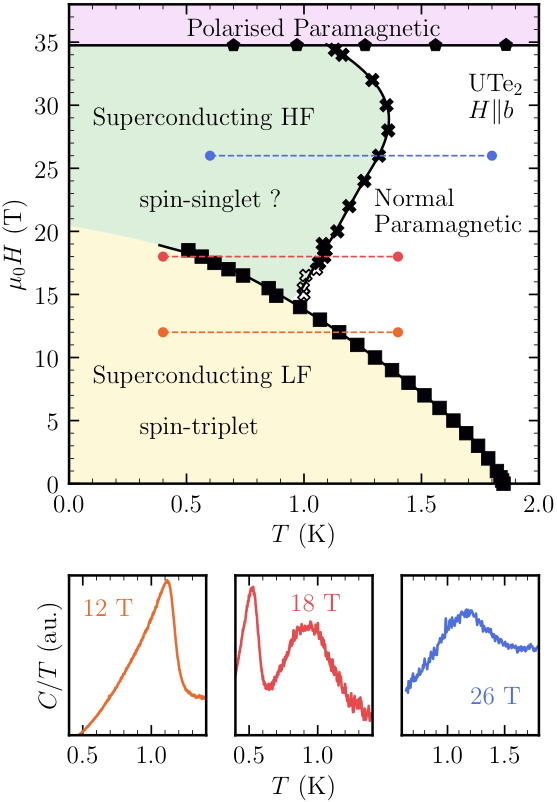For a long time, and at least till the beginning of the eighties, all known superconductors shared a common mechanism responsible for this superconducting state: the interaction between electrons and the underlying lattice, also called the electron-phonon mechanism. The discovery that superconductivity could also be induced by direct interactions between electrons, for example mediated by their magnetic properties, was a real breakthrough. Nowadays, it is realized that this seems to be always the case for strongly correlated electron systems. However, a precise identification of this pairing mechanism remains a major challenge. In the high-Tc cuprates for example, even though it is clear that electron-electron interactions are responsible for the record large critical temperatures, still no consensus emerges on which interactions control the formation of the Cooper pairs.
Very recently [1], a collaboration between our laboratory, Néel Institute, the LNCMI Grenoble and Tohoku University has shown that another strongly correlated system, UTe2, is the first system for which two different pairing mechanisms can lead to different superconducting states. Moreover, a magnetic field can tune which mechanism will drive the superconducting state.
It was known already [2] that superconductivity is reinforced in UTe2 when a magnetic field is applied in a particular crystallographic direction, corresponding to the hard magnetization axis (the b-axis of the orthorhombic structure). This very surprising phenomena has been explored on high quality crystals with new measurements of specific heat and thermal expansion, performed up to 36T and down to very low temperatures. With these probes, we could first reveal that the field-reinforcement of the superconducting state is due to a thermodynamic phase transition into a new superconducting phase above 15T (see Figure). It was also discovered that the anomaly (the specific-heat jump) which marks the transition between the normal state and the superconducting state broadens more than 4 times in the field reinforced state.

The two different superconducting phases in UTe
2 as observed by thermodynamic specific heat measurements, showing notably the transition line between the two phases. At the bottom, the change of the specific heat anomaly, becoming very broad in the high field phase is very clear: note the curve at 18T where both anomalies are successively observed on cooling. Multiple superconducting phases are already a rare phenomenon, but multiple pairing mechanism is up to now unique.
This is unique: in the very few other examples of superconductors displaying multiple superconducting phases, the superconducting states differ only by a change of symmetry, and in such a case, there is no remarkable change of the specific heat anomaly. Here in UTe2 it is likely that the low field spin-triplet superconducting phase is driven by ferromagnetic fluctuations, whereas the high field phase with a broad specific-heat anomaly would emerge from other magnetic fluctuations developing under magnetic field.
A peculiarity of the phase diagram of UTe2 apparent on the Figure is that the field-reinforced superconducting state abruptly disappears above 35T: this coincides with a metamagnetic transition, characterized by a large first-order jump of the magnetization of 0.5µB. These “other” magnetic fluctuations are most likely related to the emergence of the metamagnetic transition.
Detailed analysis [1] shows that indeed, a pairing mechanism controlled by the metamagnetic field could explain quantitatively the strong broadening of the specific heat anomaly, as well as its high sensitivity to a small misalignment of the field from the b-axis. But there is a surprise ingredient in this explanation: one has to admit that the high field phase, contrary to the low-field one, would be spin-singlet. This is counter-intuitive: a spin singlet state for the Cooper pairs is usually detrimental for superconductivity at high magnetic field, because of the loss of magnetic energy due to the alignment of spins in the field. At the opposite, a triplet state, allows to form Cooper pairs with spins polarized along the applied magnetic field, hence it should be favored at high field.
Nevertheless, this additional twist is consistent with some theoretical predictions studying precisely the competition of different pairing mechanisms in this system under pressure [3], where several superconducting phases have also been discovered [4].